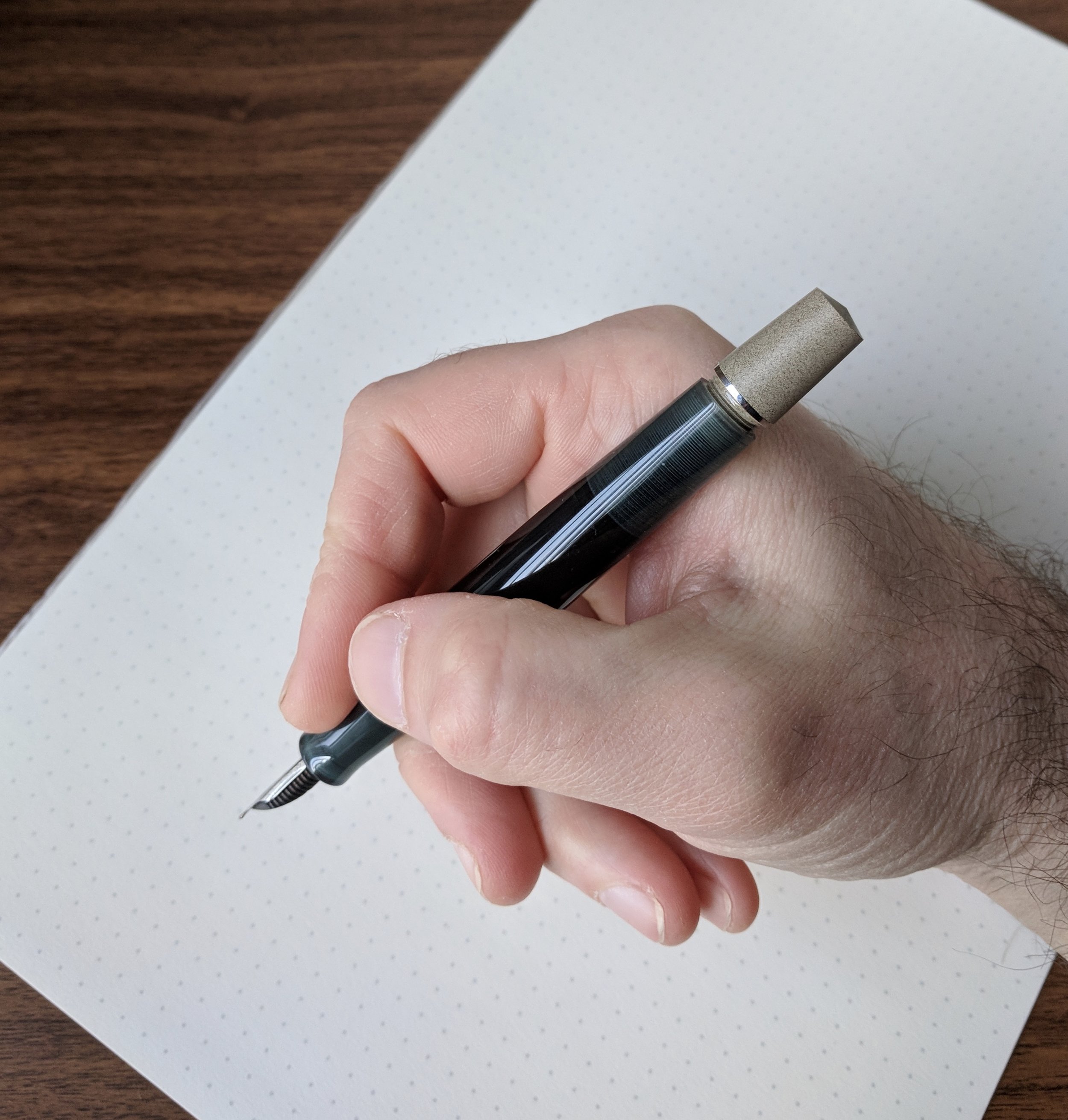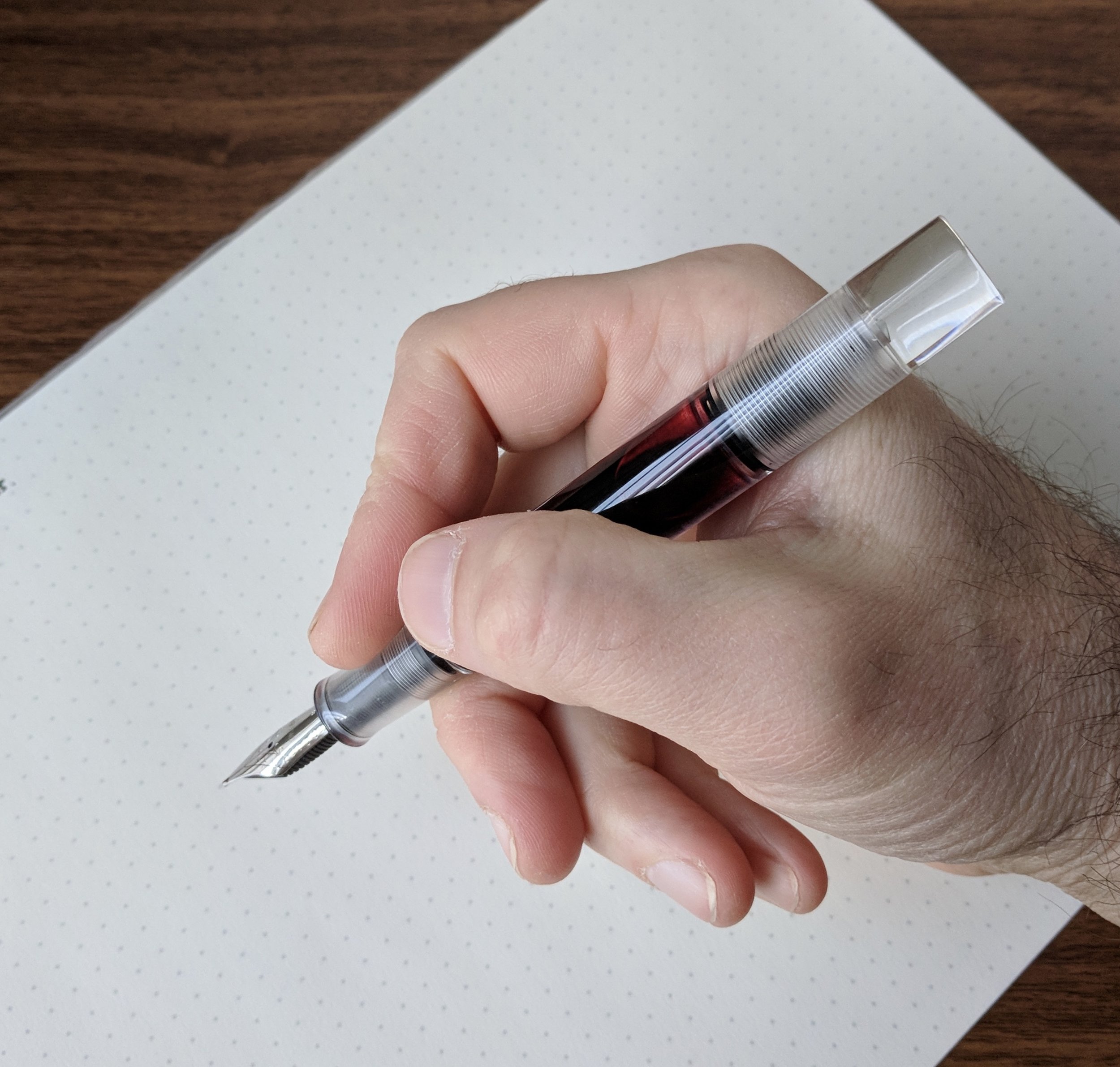Now that we're about four weeks removed from the 2024 Chicago Pen Show, I'm in a position to share my thoughts on the first of several pens I acquired at that show, including the one featured here: the Skogsy Pens Low Volume Eyedropper! Skogsy Pens is run by Zach and Amy Skogsberg, a husband-and-wife team where Zach is the primary maker and Amy can always be found handling the business end behind the table at pen shows! It’s been delightful to get to know them over the past couple of years, and what's amazing to me is that Zach has only been making pens since 2021, yet I've found his pens to be of consistently high quality with unique designs and material combinations. My favorites include Micarta and, as shown here, polished ebonite.
The combination of polished acrylic and ebonite is gorgeous and immediately when I saw this pen at the Skogsy Pens table I knew that I would not leave the show without it.
So What is The “Low Volume Eyedropper” System
The Low Volume Eyedropper showcases Zach’s creativity and innovation, combining beige and black ebonite for the cap and section with a polished clear acrylic barrel, drilled out to function as an eyedropper. It’s a cool look. For the uninitiated, eyedropper pens can feel intimidating. They typically involve filling the barrel of the fountain pen directly with ink using a pipette or dropper, and sealing the barrel threads with silicone grease or an o-ring. Most eyedroppers hold a LOT of ink, which newer users often perceive as risky because it can cause a big mess if the pen leaks from the barrel or section or "burps" ink out the front of the nib due to changes in air pressure or temperature. The Skogsy "Low Volume" eyedropper is an experimental design that looks to mitigate some of the everyday complications inherent in eyedropper pens, and make them more user friendly.
While this pen is on the shorter side for me, it’s proportionate enough in terms of diameter to maintain comfort.
The Low Volume Eyedropper - as the name implies - has been intentionally designed to hold a smaller volume of ink than your typical eyedropper in order to limit the amount of ink flowing to the feed and to allow for additional insulation of the ink chamber. (i.e., The smaller the ink chamber, the thicker the barrel, which means more material between the ink and your hand, which in turn limits temperature fluctuations that cause burping.) I understand that some additional modifications have also been made to the ebonite feed and the section to moderate the ink flow - something that can be particularly important with an eyedropper as most eyedroppers are wet writers to begin with and an ebonite feed will exacerbate that issue. I'm pleased to report that that system functions as intended: Even as I've emptied the pen, I've experienced no burping or excess flow as the eyedropper writes toward empty, and the ebonite feed maintains a steady stream of ink that's pretty much perfect for my preferences with a broad nib.
The cap/barrel seam sits dead center. The cap is 2.75” long and the exposed portion of the barrel is the same length.
The Pen's Design: Relatively Short and Sweet with a no. 8 magna carta nib
Zach originally got into making fountain pens because he had a hard time finding a size and shape that appealed to him. As he points out in his introduction, compact pens with wider grip and barrel can be difficult to find, especially at an accessible price point. It can be even harder to find a pen with these proportions that features a larger nib - personally I feel that a No. 8 nib simply looks better on a pen of this size than a No. 6. Fortunately, lower-cost stainless steel No. 8 nibs have become more widely available as both JoWo and Magna Carta now supply them to penmakers, with Magna Carta currently the most popular. (Both the Skogsy Low Volume Eyedropper and the Edison Jameson that I picked up in Chicago feature these Magna Carta nibs.)
My pen came with two nib options. The Magna Carta has been installed since the Chicago Pen Show, but I also love that surfboard design on the JoWo No. 6! (Skogsy Pens is located in San Diego.)
I will note that the Magna Carta nibs can need some tuning, which may include not only smoothing but heat-setting the nib to the feed. This process is not terribly complicated for an experienced user to do by themselves, but if you're not comfortable performing minor work on your own nibs I would highly recommend purchasing your pen at a pen show where Zach can adjust your nib in person to fit your preferences.
The Magna Carta stainless steel nib features no branding. It’s a nice standard broad nib, but….
The ebonite feed is what makes the writing experience! Adding extra flow really does up the game here.
The finish on my pen is flawless. The clear acrylic barrel is polished to perfection without any noticeable tool marks, the threads are smooth, and the ebonite on the cap and section shines. And check out that swirl at the top of the cap....
Perfectly centered.
The Low Volume Eyedropper measures approximately 5.5 inches capped, 5 inches uncapped, and 6.5 inches posted. It's a very comfortable length for me to use either posted or unposted, though I think I prefer unposted as the pen feels more balanced. The gently concave, wider-diameter section offers a good grip area, and ebonite is one of my favorite materials to write with because it takes on a warm feeling in the hand. This pen practically begs to be used everyday, and offers an extremely pleasant writing experience over longer sessions at work or at home in my journal(s).
The cap posts deeply and securely, though I think I prefer to use this one unposted.
What About the Ink and Paper Used in This Review?
In addition to test-driving the Low Volume Eyedropper, I used this review as an opportunity to try out a new ink and rediscover a favorite paper. I've always found brown/beige pens - and definitely clear-barreled eyedroppers - as excellent vehicles for showcasing red inks, so for this review I inked the pen up with Tom's Studio "Mulberry". Mulberry is a gorgeous deep burgundy that is what I consider a "solid color": without shading or sheen but it has a beautiful dark red hue with purple undertones.
What is it about brown/beige/grey pens and red inks?
As I mentioned above, the broad No. 8 Magna Carta Nib writes a bold wet line, and I had no issues with the Mulberry feathering or bleeding on the paper I've used here, which is the Blackwing "Illegal Pad". I've written before on my frustration with finding decent, reasonably priced legal-style pads capable of handling fountain pen ink, and I'm glad that Blackwing has now made these pads more widely available. Cool Note: The lined pads shown here feature a legal/steno layout, which is a lined pad with a center dividing line that we attorneys have traditionally used for various purposes such as organizing questions and corresponding answers at deposition or in court, as well as for checklists and research task management.
The Skogsy Low Volume Eyedropper (center), compared to two pens I’ve recently reviewed: the TWSBI ECO Caffé Bronze (right) and the Kaweco Sport Piston Filler (left).
Takeaways and Where to Buy
At the Chicago Pen Show, the Skogsy Low Volume Eyedropper was priced at $340, which included a stainless steel Magna Carta No. 8 nib AND an extra Jowo No. 6 section and nib with the Skogsy surfboard design. I consider this excellent value given the craftsmanship and versatility. I have not yet tried out this pen with a No. 6 nib, and I’ll be interested to see whether it changes my perception of the balance or the writing experience.
The polished ebonite showcases a good bit of grain. Polished ebonite is one of my favorite fountain pen materials, and highly underrated.
As of the date of this post, Skogsy Pens does not have any Low Volume eyedroppers listed for sale on their website, as they are in the middle of Pen Show Season and stock needs to be reserved for shows (This is frequently the case with many smaller makers.) If you're interested in this particular pen, you have a few different options: Keep checking their online shop or contact them directly to place an order for a commission, follow Skogsy Pens on Instagram, or even better, visit them at a pen show! They list all upcoming shows online, and will be appearing at the Dutch Pen Show in June, the D.C. Pen Show at the beginning of August, and the San Francisco Pen Show at the end of August.
Another writing sample with the Mulberry ink, this time on Midori MD Cotton Paper.
The ink and paper featured in this review can be purchased in our own shop, as we carry the entire line of Tom's Studio Fountain Pen Inks, including Mulberry. You can read more about these inks ($16 for a 50ml bottle) and view swatches here. We also sell the Blackwing "Illegal Pads", which come in packs of two pads (priced at $20) and are available in blank, dot, and classic "legal pad lined" formats.
Did you enjoy our content? Consider supporting us directly by visiting the T.G.S. Curated Shop, or pledging via the T.G.S. Patreon Program. We greatly appreciate all our reader and customer support. I purchased the Skogsy pen shown here with my own funds, for review purposes, and was not compensated for this review.



